#from Ponce to San Juan
Explore tagged Tumblr posts
Text





🇵🇷 Not surprisingly, we found another bakery in between Ponce and San Juan. 🥖🍩☕️
#bakery#panderia#Cayey Puerto Rico#donuts#coffee#desserts#sugary donuts#coffee and donuts#Puerto Rican bakery#Saturday afternoon#from Ponce to San Juan
5 notes
·
View notes
Photo
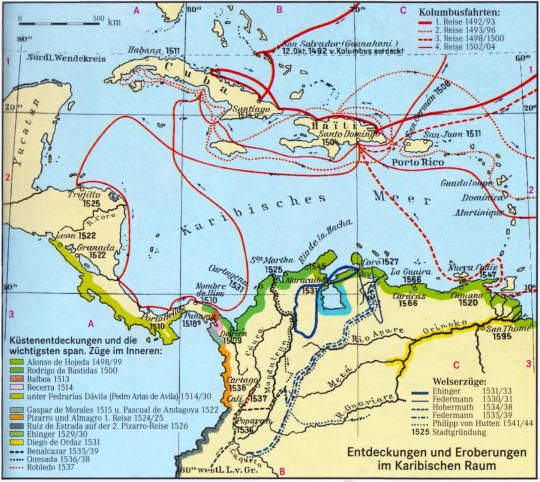
Discovery and conquest of the Caribbean Sea by the Spanish, 1492-1595.
« Westermann Großer Atlas zur Weltgeschichte », 1997
by cartesdhistoire
On October 12, 1492, Christopher Columbus reached San Salvador in what is now the Bahamas archipelago, then he discovered the northeast coast of Cuba and Haiti (La Española). During a second expedition, he discovered Dominica and Guadeloupe, then he explored the south coast of Cuba and discovered Jamaica (Santiago). His brother Bartolomé founded Santo Domingo in 1498. In 1508, Ponce de León named a harbor on the island Puerto Rico, which took its name, then he founded San Juan in 1511.
During his third voyage, in 1498, Columbus reached the island of Trinidad and discovered the mouths of the Orinoco River: the flow of the river indicated that the hinterland was much larger than the islands previously discovered. So, the idea of “mainland” began to emerge. In 1499, Alonso de Ojeda, accompanied by Amerigo Vespucci, explored the coast from east to west, starting from Guyana. On the shores of Lake Maracaibo, upon seeing Indians living in huts on stilts, he named this region “Venezuela”, meaning little Venice.
Rodrigo de Bastidas discovered the mouth of the Magdalena River and was the first to land on the Isthmus of Panama in 1500. During his fourth voyage, Columbus sailed along the coast of the isthmus from present-day Honduras (1502). Vasco Nuñez de Balboa founded Santa María la Antigua del Darién in 1510, the first permanent colony on the mainland, then he discovered the “South Sea” in 1513. Pedrarias Dávila founded Panama in 1519.
In 1528, Charles V granted the exploitation of Venezuela to Augsburg bankers, the Welsers. The expedition of Nicolás de Federmán reached the land of the Muiscas in the Andes in 1539.
The first European to ascend the Orinoco was Diego de Ordaz in 1531 (he was also the first European to reach the summit of the Popocatépetl volcano in Mexico). Where the Orinoco narrows the most, Antonio de Berrío founded the town of Santo Tomás de Guayana in 1595.
In the Andes, Benalcázar founded the Spanish Quito in 1534, then Popayán in 1537, and Jiménez de Quesada founded Santa Fe de Bogotá in 1538.
96 notes
·
View notes
Text
Isabella Mellado.

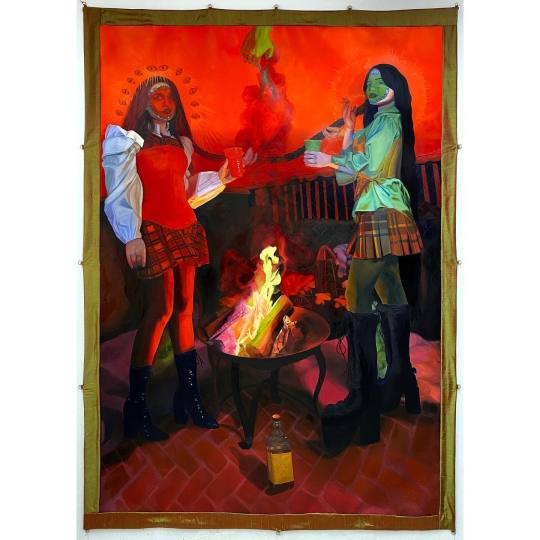
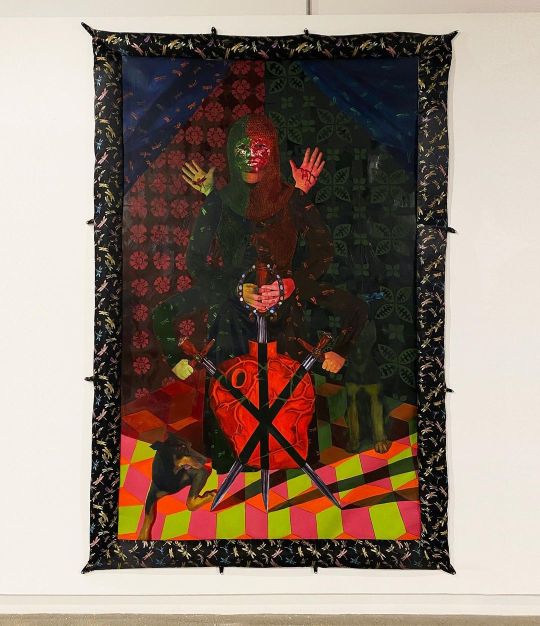
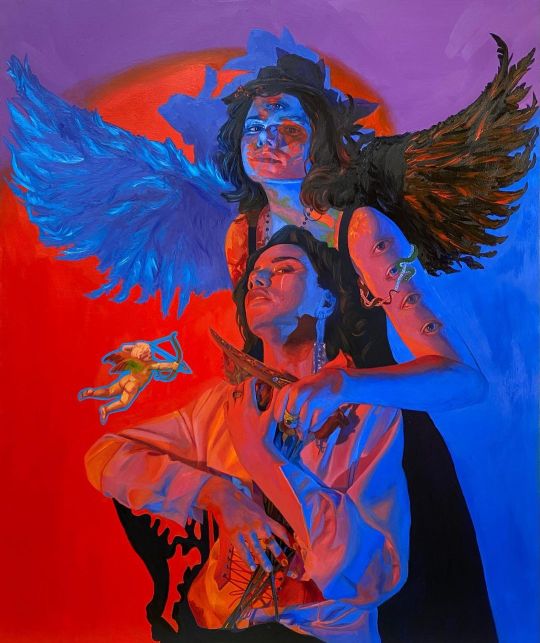
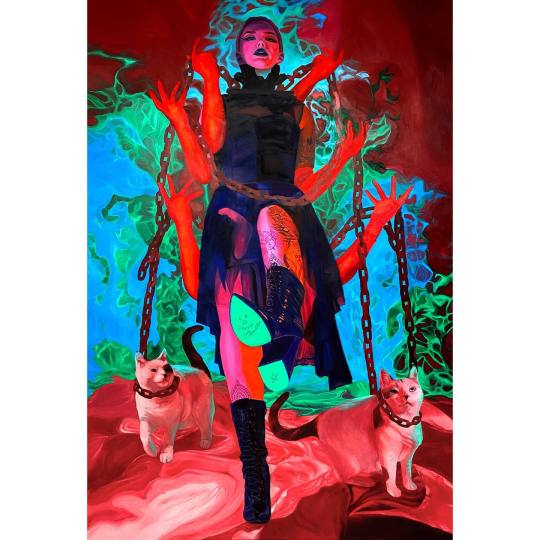
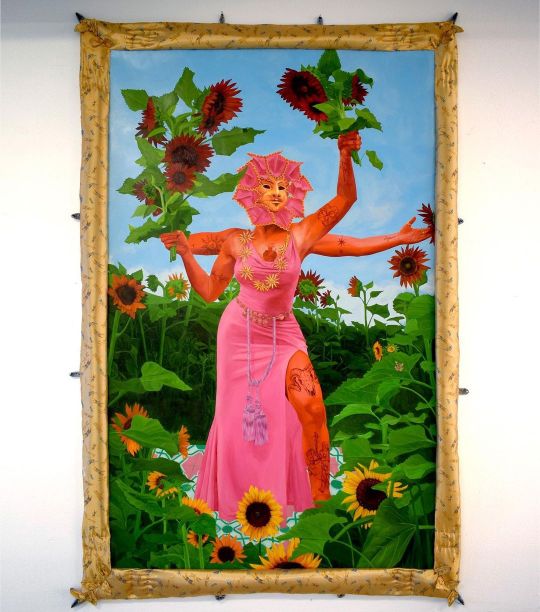
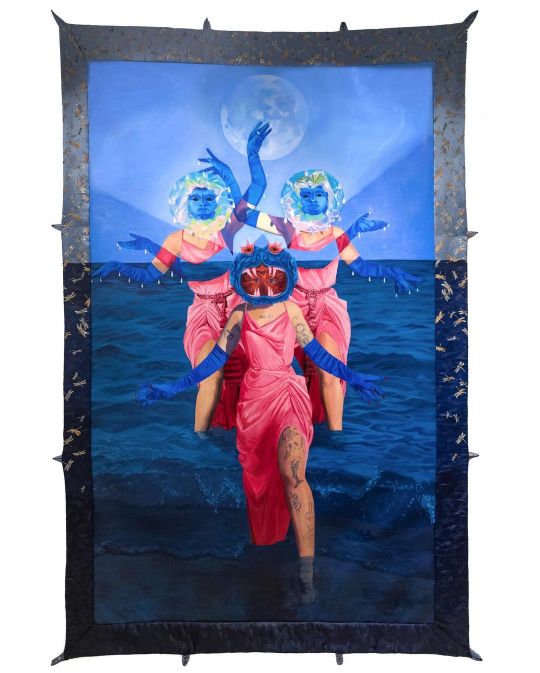
Exceptional contemporary figurative works from San Juan, Puerto Rico born artist Isabella Mellado.
Mellado, now based in Chicago, is renowned for her magical realist paintings exploring latinidad, queer identity, and tarot, working across various media such as painting, photography, costume design, digital collage, and sculpture.
Mellado's work has been showcased in prestigious venues such as Kavi Gupta Gallery in Chicago, Walter Otero Contemporary Art in San Juan, Pulse Contemporary Art Fair in Miami, The Ponce Biennial in Ponce, and MECA Art Fair in San Juan, among others. She has also participated in residencies at Ox-Bow in Saugatuck, Michigan, the Studios at Mass MoCA in North Adams, Massachusetts, and the Vermont Studio Center in Johnson, Vermont.

THE SUPERSONIC ART SHOP | FOLLOW ON INSTAGRAM
#art#painting#isabella mellado#chicago artist#artwork#contemporary art#modern art#tarot#queer identity
64 notes
·
View notes
Text
Events 2.20 (before 1940)
1339 – The Milanese army and the St. George's (San Giorgio) Mercenaries of Lodrisio Visconti clash in the Battle of Parabiago; Visconti is defeated. 1472 – Orkney and Shetland are pawned by Norway to Scotland in lieu of a dowry for Margaret of Denmark. 1521 – Juan Ponce de León sets out from Spain for Florida with about 200 prospective colonists. 1547 – Edward VI of England is crowned King of England at Westminster Abbey. 1685 – René-Robert Cavelier establishes Fort St. Louis at Matagorda Bay thus forming the basis for France's claim to Texas. 1792 – The Postal Service Act, establishing the United States Post Office Department, is signed by United States President George Washington. 1798 – Louis-Alexandre Berthier removes Pope Pius VI from power. 1813 – Manuel Belgrano defeats the royalist army of Pío de Tristán during the Battle of Salta. 1816 – Rossini's opera The Barber of Seville premieres at the Teatro Argentina in Rome. 1824 – William Buckland formally announces the name Megalosaurus, the first scientifically validly named non-avian dinosaur species. 1835 – The 1835 Concepción earthquake destroys Concepción, Chile. 1846 – Polish insurgents lead an uprising in Kraków to incite a fight for national independence. 1864 – American Civil War: Battle of Olustee: The largest battle fought in Florida during the war. 1865 – End of the Uruguayan War, with a peace agreement between President Tomás Villalba and rebel leader Venancio Flores, setting the scene for the destructive War of the Triple Alliance. 1872 – The Metropolitan Museum of Art opens in New York City. 1877 – Tchaikovsky's ballet Swan Lake receives its premiere at the Bolshoi Theatre in Moscow. 1901 – The legislature of Hawaii Territory convenes for the first time. 1905 – The U.S. Supreme Court upholds the constitutionality of Massachusetts's mandatory smallpox vaccination program in Jacobson v. Massachusetts. 1909 – Publication of the Futurist Manifesto in the French journal Le Figaro. 1913 – King O'Malley drives in the first survey peg to mark commencement of work on the construction of Canberra. 1920 – An earthquake kills between 114 and 130 in Georgia and heavily damages the town of Gori. 1931 – The U.S. Congress approves the construction of the San Francisco–Oakland Bay Bridge by the state of California. 1931 – An anarchist uprising in Encarnación, Paraguay briefly transforms the city into a revolutionary commune. 1933 – The U.S. Congress approves the Blaine Act to repeal federal Prohibition in the United States, sending the Twenty-first Amendment to the United States Constitution to state ratifying conventions for approval. 1933 – Adolf Hitler secretly meets with German industrialists to arrange for financing of the Nazi Party's upcoming election campaign. 1935 – Caroline Mikkelsen becomes the first woman to set foot in Antarctica. 1939 – Madison Square Garden Nazi rally: The largest ever pro-Nazi rally in United States history is convened in Madison Square Garden, New York City, with 20,000 members and sympathizers of the German American Bund present.
2 notes
·
View notes
Text
» La•Colonia 🇵🇷 Site Map
» La Mentalidad Boricua

Diosa Luna (Taíno Moon Goddess), Los Hermanos Guillén, Yamasá, República Dominicana. La Española was the first Spanish colony in the New World, preceding Puerto Rico by 15 years. It became independent twice, in 1844 from Haiti (which had invaded in 1822) and in 1865 from Spain (to which Santo Domingo had been restored by President Pedro Santana in 1861 due to bankruptcy). After 1865, Spain's colonies in the Americas were reduced to Cuba and Puerto Rico. Cuba obtained independence from Spain in 1898 and from the United States in 1902. Puerto Rico became a possession of the United States in 1898. "Of all Spanish colonial possessions in the Americas, Puerto Rico is the only territory that never gained its independence." Marisabel Brás, The Changing of the Guard: Puerto Rico in 1898
Site banner photo: a garita (colonial sentry box) of the Old San Juan Spanish fortress complex —which includes Castillo San Felipe del Morro (El Morro) and Castillo San Cristóbal, the largest Spanish fortification in the New World— keeps silent watch over the tropical Atlantic. Photo by Michellewint @ Wallpapercave.com
San Juan National Historic Site
National Park Service

Diego Azeta has no actual physical existence in four-dimensional space-time. He is an imaginal cognitive framework emerging from symbolic domains etched on hypermedia substrates on the Web. Diego interacts with the world as a cybernetic-anthropic systems analyst.
📚 📜 🗿 🌐 🧭 💻 📱 🤖 ⚡ 🔆 🔊
The last of the European colonial possessions can shed much light on the social behaviors of countries the world over, including the former colonial powers themselves. It is often easier to diagnose the failings of other cultures than to critically examine those of your own. (This is the overlooked beam in thine eye judgment bias.)
Another key point illustrated here is the use of unfair policies that ruling powers impose on ethnicities and inchoate nations they control. (This is the might makes right political fallacy.) These extraneous conditions, often intended to crassly project colonial power, become psychosocially onerous and contribute to the erosion of the cultural fabric that sustains the moral traditions and norms of conduct of the colonial society.
The main point of the presentation, however, is to showcase the egregious irresponsibility of the colony's political and social leaders when they abdicate their patrimonial duty to demolish the mentality of submission and lead the people to freedom, not just from the colonizers but more importantly from the rank, metastasized corruption the colonial leaders and inhabitants have learned, adopted and further developed on their own. People are always responsible for the consequences of their deeds and attitudes.

Borikén Taíno Map c. 1508 —goodrusk.com
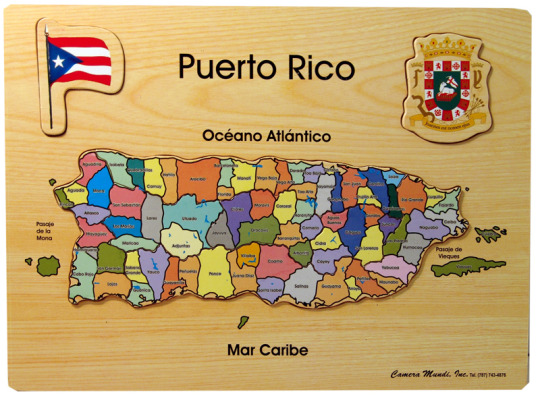
Puerto Rico's 78 municipalities (offshore islands not distanced to scale) —CameraMundi.com
Enjoy your visits here, my friends.


Brush up on the basics:
If opening these links in Chrome is objectionable to you, you can point to and hover on the link which copies the url, and paste it on your favorite web browser.
What is a logical fallacy? - Grammarly
What is critical thinking? - Monash University
{Breve Historia de Puerto Rico - EnciclopediaPR.org
Brief History of Puerto Rico - EncyclopediaPR.org}
History of Puerto Rico - Britannica
{Historia de Puerto Rico - Wikipedia
History of Puerto Rico - Wikipedia}
Puerto Rico - Britannica
Puerto Rico - CIA World Factbook
Puerto Rico - NationsOnline.org
Puerto Rico - Wikipedia (English, Español)
Puerto Rico - WorldData.info
Colonialism - National Geographic
Colonialism - Wikipedia
Colonialism - Stanford Encyclopedia of Philosophy

Columbus lands in Guanahaní (San Salvador), 12 October 1492. Image: PBS Learning Media/GBH. Columbus also discovered Borikén (San Juan Bautista, later Puerto Rico) on his second voyage on 19 November 1493.

Juan Ponce de León y el cacique Agüeybaná en Borikén en 1508.
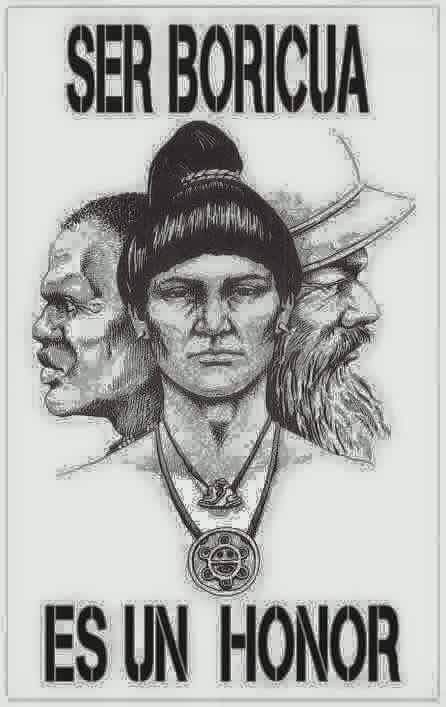
-> Afírmalo con integridad en tus obras y proceder.
“Los buenos somos más.” 🇵🇷
— Profesora B. López
Los corruptos serán los menos. ☣️
⚙️ Settings: This blog is best viewed on the Tumblr app with the color palette set to dark mode.
Original author material in La•Colonia blog is © 2023-2025 Diego Azeta. All rights reserved. Derechos reservados. Downloading this material to the user's device for offline, non-commercial, personal reading use is authorized. Use of the material for commercial purposes is disallowed.
Puerto Rico is officially bilingual. So is this blogsite. Check out free online translation options at HelpDeskGeek.com
Visit Diego Azeta's geopolitics blog @ Tumblr:

» Azeta 🌐 Azota
» Site map
2 notes
·
View notes
Text
Singlaub Recruits His Own Army in the Philippines

The National Reporter (formerly CounterSpy) Volume 10, Number 3
Since October 1986, retired General John Singlaub has spent much of his time in the Philippines, and has now set up an office in Manila. He claims that he is there only to hunt for treasure left by Japanese General Tomoyuki Yamashita after World War II, but a growing body of evidence suggests that he may also be involved in advising or assisting in the development of counter-insurgency plans and capabilities and in the development of right-wing, anti-communist organizations.
While stationed in Vietnam from 1966 to 68, Singlaub was one of the on-site commanders of Operation Phoenix, a program responsible for the assassination of some 20,000 Vietnamese civilians. Presently he is chairman of the World Anti-Communist League (WACL) and is extensively involved in fund-raising for the contras. Singlaub set up an office at 2298 Pasong Tamo extension, Manila, in offices of the Nippon Star Company. Nippon Star is a subsidiary of Nippon Electric Company which supplies materials for telecommunications projects in Ilocos and Cagayan, the provinces of Ferdinand Marcos and Juan Ponce Enrile respectively. A Restricted Area sign guards the office.
Enrile told reporters that he met with Singlaub three times in 1986. He refused to answer when asked if he believed that Singlaub was in the Philippines on a treasure hunt. Particular concern was expressed in the Manila press over reports that he was joined in his meetings by former CIA deputy chief Ray Cline and CIA Philippine station chief Norbert Garrett. According to a San Francisco Examiner report, Singlaub has been using Enrile's introduction to meet officers associated with the pro-Enrile Reform of the Armed Forces Movement (RAM). One senior officer said Singlaub was engaged in arms trading and was offering to sell equipment useful in counter-insurgency operations.

A former Western military officer familiar with arms trading in the Philippines said Singlaub tried to sell M-16 automatic rifles and communications equipment on the local black market. Another senior military officer said the Philippine military was developing a right-wing vigilante movement in the countryside. The Manila Chronicle reports that Singlaub has offered financial support to sugar planters on the island of Negros who are mounting an anti-communist drive and that people close to Singlaub have also offered weapons and logistical support to vigilante-type organizations linked to the Marcos loyalists.
Singlaub has met with a number of conservative Philippine politicians including Homobono Adaza, Roilo Golez, and Eva Estrada Kalaw. Ms. Kalaw, a former senator who intends to run again this year, is vice-president of the Philippine Anti-Communist Movement, the Philippine chapter of WACL. One meeting was at a January 26, 1987 dinner party hosted by General Luis Villa-Real, head of the National Intelligence Coordinating Authority and president of the Philippine WACL chapter. Villa-Real has been instrumental in the development of right wing paramilitary groups such as the Alsa Masa (Rising Masses) which has been terrorizing Agdao, Davao City.

▲ John Singlaub and Mike Flynn, 2018 The Philadelphia Inquirer and the Washington Post reported on February 15 that Singlaub has recruited at least 37 Americans, Asians and other nationals who served with the U.S. Special Forces in Vietnam to train [Philippine] soldiers in unconventional warfare techniques, according to an official familiar with U.S. and Philippine military affairs who has close contact with intelligence agents monitoring Singlaub's activities. Singlaub denied that he is recruiting mercenaries saying, "I know nothing about any American mercenaries coming to the Philippines. ... It's a fabrication, the idea that I’m involved in any training activity." He suggested that the reports were orchestrated by the KGB.
General Singlaub did admit that he had hired six Americans but said that most of them are not veterans. The Tower Commission report shows that Singlaub’s contra fund-raising activities were coordinated with Oliver North and Richard Secord, both of whom are under investigation for their role in Iran weapons deals. Secord and North were associates of Singlaub in Vietnam. Another possible link between Singlaub and Iran is his relationship with Ramon Moreno, a Filipino military contractor who is currently under investigation by a U.S. grand jury for alleged corruption in awarding Armed Forces of the Philippines military contracts to a California firm which Moreno controls. Moreno, a friend of Singlaub's, owns the building where Singlaub has his office.
Moreno is also a close associate of General Fabian Ver, Philippine military Chief of Staff under Marcos. A December 10 San Francisco Examiner report ties Ver to the Iran arms deals by the fact that Ver provided fake resale certificates to an Israeli arms dealer in an apparent effort to keep Secretary of State Shultz from discovering U.S. weapons were going to Iran. An unidentified Filipino arms dealer reportedly close to Ver received a five percent commission from the Iranian arms sales proceeds for providing the certificates. U.S. Attorney Theodore Greenberg, who is investigating the Moreno case, is seeking these documents.
General Singlaub served as an officer in the OSS during World War II both in Europe and in China. In 1946 he became the chief of the U.S. military liaison mission to Mukden, Manchuria, and in 1949 he became the China Desk officer for the CIA. After helping to establish the Ranger Training Center at Fort Benning, Georgia, he was assigned to South Korea during the Korean War as CIA deputy chief. He remains a close associate of former CIA director William Colby, who headed the Phoenix Program in his role as director of the U.S. CORDS mission in Vietnam. Later Singlaub was commander of the U.N. forces in South Korea. In 1978 he retired from the military after disagreeing with President Carter's decision to reduce the number of U.S. troops there. Related info below
General John Singlaub (former Chairman of World Anti-Communist League, unconventional warfare expert, former commander of U.S. troops in South Korea):
His [Moon’s] organization, from my point of view was more of a political effort, that is to save the world from the ‘evil empire’ than it was to save individuals from the devil.
CAUSA and Moonie Counterinsurgency in the Philippines (International Relations Center / Interhemispheric Resource Center’s 1989 report on the Unification Church):
In the Philippines, CAUSA is helping to set up civilian vigilante groups, elect local rightwing officials, and influence public opinion regarding the U.S. bases negotiations. The Special Operations Teams (SOTs) of the Philippine Army use a manual prepared by CAUSA Intl for their anticommunist lectures. The SOTs are counterinsurgency squads which use political and psychological methods–including anticommunist propaganda–to win the “hearts and minds” of Filipino peasants. A CAUSA affiliate, the Asian Ecumenical Inter-Faith Council itinerated Father Bismarck Carballo for a speaking tour in the Philippines in August 1986. Carballo was an opposition clergyman in Nicaragua who at one time was evicted by the Sandinista government. In October, 1986, CAUSA held a National Security Conference in the country that was attended by Ray Cline and John Singlaub, both experts on counterinsurgency strategy and low intensity conflict.
Excerpt from Moon’s Law: God Is Phasing Out Democracy
In 1975, Moon publicly denounced WACL as “fascist” and purportedly withdrew; however, this was most likely simply an effort to keep a lower profile. The Washington Post, covering the 1978 WACL conference in Washington, reported that the Unification Church was absent and no longer involved.16 However, a Unification Church minister hired buses for CIA-connected Cuban exiles to attend, according to interviews with the Cubans by Jeff Stein, writing in New York magazine.17 It is clear that the Moon organization never really left WACL. Osami Kuboki has been a member of the WACL executive board for many years, and even hosted the 1982 WACL conference in Japan.
Excerpt from Moonies alienate our children and serve the CIA By Larry Henares Jr.:
The Moonies function under different names: the Washington Times newspaper in Foggy Bottom; the Moonies’ political arm, the CAUSA International; and Asian Ecumenical Inter-Faith Council. Among the top leaders of CAUSA International, are Cleon Skousen, a Mormon Church leader, Douglas MacArthur II, and Bo Hi Pak, formerly of the Korean CIA who chairs the organization and admits CIA funding. In August 1986, Ulrich Vokel of Asian Ecumenical Inter-Faith Council, contacted Brother Rafael Donato of the Association of Major Religious Superiors of the Philippines (AMRSP), asking for an audience for Nicaraguan priest Msgr. Bismark Carballo of the US-backed Contras against the Sandinistas. The AMRSP refused because Msgr. Carballo’s trip was paid for by CAUSA. CAUSA sponsored a seminar at the National Defense College, and an October 4 conference in Manila Hotel both of which were attended by Minister Johnny Ponce Enrile, and reportedly co-sponsored by La Salle University, in the person of its president Bro. Andrew (now Bulletin president). Raul S. Manglapus bitterly criticized the tone of the conference, assailed the National Defense College for lending its name to an extreme right-wing organization, and protested the presence of such Marcos supporters as A. James Gregory, and Ray Cline, formerly CIA deputy director. There were other characters sponsored by CAUSA coming in and out of the Philippines: General John Singlaub fired by Carter for his extremist views, then chairman of the World Anti-Communist League, funded by the Moonies; Edgar Chamorro, CIA-supported right wing extremist brought here by CAUSA to have an audience with President Cory. On August 12-14, 1986, CAUSA-sponsored International Security Council met in Manila to draft the “Manila Declaration”’ which asked the USA to be Policeman of Southeast Asia, sought “the retention of military facilities in the Philippines, and the enhancement of an American deterrent capability that will contain the formidable Soviet military threat… “Among the signatories: Carolina G. Hernandez of U.P.; Brig. Gen. Florencio Magsino (Ret.); Santanina T. Rasul; Pablo Tangco of U.S.T.; and Angelesio Tugado, National Defense College. Raul Manglapus attacked the “Declaration” as a justification of a military take-over. And in November a rightist military plot was uncovered. On March 8, 1987, in the Dao Room of the Manila Hotel, a three-day conference on Anti-Communism was sponsored again by CAUSA, attended by militarists, religious extremists and rightist politicians, such as Vice President Salvador Laurel, Colonel Koronel, General Abenina, and Brother Andrew from La Salle (now Bulletin president). And five months later on August 28, 1987, a military coup was attempted. Others in CAUSA Conferences were: Monsignor Moises Andrade, Monsignor Ted Bacani who delivered a special message from Jaime Cardinal Sin; Education Minister Lourdes Quisumbing; Colonel Rodolfo Biazon of the Philippine Military Academy; Dr. Gloria M. Santos of the Asian Ecumenical Interfaith Movement; Mr. Rogelio Lizada of the Council of the Laity; Atty Danilo Deen, Integrated Bar (IBP); Princess Tarhata Lucman of Tawi-Tawi; Sonia Zaldivar-Ronda, CLP treasurer.
Related:
Private Groups Step Up Aid to ‘Contras’ (1985)
John Singlaub: 'An Anti-Communist's Anti-Communist'
The WACL and CAUSA’s Role in the Ruthless Violence of US-Philippines Counterinsurgency
On Moon’s Political Network and their Deep Connections to Global Terrorism
Chun Doo-hwan’s Pushed WACL?
Dallas Hosts Anti-Communist League (1985)
On Yamashita’s Gold, Singlaub, and the Events Following Marcos’ Departure
Reverend Moon: Cult leader, CIA asset, and Bush family friend is dead
The Moonies and 'Victims of Communism'
The Dark Shadow Cast by Moon Sun Myung’s Unification Church and Abe Shinzo - Asia-Pacific Journal Japan Focus
#john singlaub#singlaub#wacl#world anti-communist league#fascism#u.s. military#causa#philippines#anti-communism#counterinsurgency
1 note
·
View note
Text
This is the 2010 Christmas Station ID of ABS-CBN. The Christmas Station ID was themed “Da Best Ang Pasko ng Pilipino”
The Christmas Station ID Theme was sung by Filipino singer and songwriter Lea Salonga and the Christmas Carollers from ABS-CBN, GMA and TV5.
The Christmas Station ID contains AiAi de las Alas, Lorna Tolentino, Zsa Zsa Padilla, The Tulfo Brothers, Mariel Rodriguez, Krystal Reyes, Toni Gonzaga, Rico Barrero, Tom Rodriguez, Hayden Kho, Bayani Agbayani, Raymond Bagatsing, Hero Angeles, Bea Alonzo, Marco Alcaraz, Lucho Ayala, Gil Cuerva, Rainier Castillo, Junell Hernando, Jay Manalo, Marlo Mortel, Jan Nieto, Diego Castro III, Chuckie Dreyfus, Mark Anthony Fernandez, Bernadette Sembrano, Cherie Mercado, Mariz Umali, Vicky Morales, Kara David, Ted Failon, Arnold Clavio, Jiggy Manicad, Noli de Castro, Jun Veneracion, Marc Logan, Arra San Agustin, Rufa Mae Quinto, Daniel Padilla, Alwyn Uytingco, Dominic Roco, Felix Roco, Angelica Panganiban, Alex Gonzaga, Cristine Reyes, Roxanne Guinoo, Valerie Concepcion, Camille Prats, Jennylyn Mercado, Kylie Padilla, Bela Padilla, Carla Abellana, Andrea Torres, Bianca Umali, Marian Rivera, DingDong Dantes, Robin Padilla, Martin Nievera, Heart Evangelista, Erich Gonzales, Dimples Romana, Gabby Concepcion with his daughter KC Concepcion, Eddie Gutierrez and Ruffa Gutierrez, Kim Chiu, Xian Lim, Zoren Legaspi, Arcee Muñoz, Alice Dixson, Tuesday Vargas, Ritz Azul, Eula Caballero, Paolo Bediones, Sharon Cuneta, Rodolfo “Dolphy” Quizon, Piolo Pascual, Willie Revillame, Janno Gibbs, Mike Enriquez, Henry Omaga-Diaz, Karen Davila, Cheryl Cosim, Jessica Soho, Amelyn Veloso, Anthony Taberna, Alvin Elchico, Sunshine Dizon, Sue Ramirez, Cesar Montano, Ogie Diaz, Arthur Solinap, Joem Bascon, Jodi Sta. Maria, Richard Yap, Albert Martinez, IC Mendoza, Arjo Atayde, Jayson Gainza, Patrick Garcia, AJ Perez, Carl Cervantes, Jerome Ponce, Christian Bables, Terence Baylon, JM de Guzman, Jeric Gonzales, Albie Casiño, Chad Kinis, Paolo Serrano, Derek Ramsay, Carlos Agassi, Eric Fructuoso, Michael V., Allan K., Edu Manzano, Jericho Rosales, JC de Vera, Martin Escudero, Gerald Anderson, Sef Cadayona, Edgar Allan Guzman, John Lloyd Cruz, Sam Milby, Luis Manzano, Matteo Guidicelli, John Prats, Ces Oreña-Drilon, Carmina Villaroel, Eugene Domingo, Nora Aunor, Leandro Muñoz, Kristine Hermosa, Meg Imperial, Gelli de Belen, Janice de Belen, Shawn Yao, Keempee de Leon, Eula Valdez, RK Bagatsing, Claudine Barretto, Ian Veneracion, Jose Manalo, Wally Bayola, Kim Atienza, Charo Santos-Concio, Cherry Pie Picache, Judy Ann Santos, Tito Sotto, Vic Sotto, Joey de Leon, Jess Lapid Jr., Vhong Navarro, Billy Crawford, Teddy Corpuz, Isko Moreno, Mico Halili, JP de Guzman, Mel Martinez, Neil Ryan Sese, Long Mejia, Jolo Revilla, Bong Revilla, Paolo Ballesteros, Oyo Boy Sotto, McCoy de Leon, Jhong Hilario, Ryan Agoncillo, Maine Mendoza, Catherine Bernardo, RJ Padilla, Aga Muhlach, Bembol Roco, Geoff Eigenmann, Gabby Eigenmann, Bernard Palanca, Mico Palanca, featuring twin brothers Rodjun and Rayver Cruz, twin sisters Anne Curtis and Jasmine Curtis-Smith, the Artista Academy students who are the original cast members of Goin’ Bulilit except for Nash Aguas, Valeen Montenegro, David Licauco, Vince Gamad and Lianne Valentin but eventually they are the permanent actors from TV5. Somehow, The Christmas Station ID includes the Trenderas trio, the half-Pinoy group Juan Direction, the largest boy band in South Korea which is Seventeen, the Supergroup Group of 30, the Spice Girls, DJ Lance the Purple Dinosaur from Sesame Street, president Noynoy Aquino as Santa Claus and Queen Elizabeth II who is Princess Elsa’s mother. The Christmas Station ID also contains child actress Ryzza Mae Dizon replacing Angelica Panganiban who is now an adolescent person. Somehow, The Christmas Station ID also features Lea Salonga who was dressed up as “Mrs. Claus”. At the very end, The book closes with sparkles coming out and the text “The End” at the end cover appears similar to the 2010 Station ID of GMA with the 2005 ABS-CBN logo and the text at the bottom that says “Maligayang Pasko, Kapamilya!”
This is the first Christmas Station ID to feature the crew from ABS-CBN, GMA and TV5.
But sadly, Mark Anthony Fernandez, IC Mendoza, Marco Alcaraz and DingDong Dantes have already moved to TV5 in 2010. Due to this, Mark Anthony Fernandez moved to TV5 when his father Rudy Fernandez died of a stroke in April 9, 2010. He was 57 years old. Somehow, He did not appear in the 2010 Christmas Station ID of ABS-CBN.
#abs-cbn#dabestangpasko#da best ang pasko ng pilipino#merry christmas#happy holidays#christmas station id#maligayang pasko
0 notes
Text
Puerto Rico Industrial Air Compressor Market Landscape and Future Developments 2024 - 2032
The industrial air compressor market in Puerto Rico is a vital segment of the island's manufacturing and service industries. With the growing need for energy-efficient and reliable air compression solutions, this market is evolving to meet the demands of various sectors, including pharmaceuticals, manufacturing, and construction. This article explores the dynamics of the market, highlighting key trends, challenges, and future prospects.
Market Overview
Definition of Industrial Air Compressors
Industrial air compressors are machines designed to convert power into potential energy stored in compressed air, which can be utilized in various industrial applications. These compressors play a crucial role in enhancing productivity and efficiency across multiple sectors, including manufacturing, food processing, and healthcare.
Market Size and Growth
The Puerto Rican industrial air compressor market has been witnessing steady growth, driven by the expansion of industries and a focus on automation and efficiency. The demand for compressed air solutions is particularly pronounced in the manufacturing and pharmaceutical sectors, which are integral to the island's economy.
Key Drivers of Market Growth
Expanding Manufacturing Sector
Puerto Rico's manufacturing industry, particularly in pharmaceuticals and electronics, is a significant driver of the air compressor market. The increasing demand for precision and automation in manufacturing processes necessitates reliable air compression solutions.
Infrastructure Development
Ongoing infrastructure projects across Puerto Rico are boosting the demand for air compressors in construction and related industries. These projects require heavy machinery that often relies on compressed air for optimal performance.
Emphasis on Energy Efficiency
As businesses strive to reduce operational costs and minimize environmental impact, there is a growing preference for energy-efficient air compressors. This trend is supported by regulatory frameworks aimed at promoting sustainability in industrial operations.
Types of Industrial Air Compressors
Positive Displacement Compressors
Positive displacement compressors, including rotary screw and reciprocating types, are the most commonly used in Puerto Rico. Their ability to deliver consistent airflow makes them suitable for various applications, from manufacturing to healthcare.
Dynamic Compressors
Dynamic compressors, such as centrifugal compressors, are becoming increasingly popular in large-scale industrial applications. Their capacity to handle high volumes of air makes them ideal for sectors like petrochemicals and energy.
Market Segmentation
By Application
Manufacturing
Pharmaceuticals
Construction
Food and Beverage
Healthcare
By Region
San Juan
Ponce
Bayamón
Caguas
Challenges Facing the Market
Economic Stability
Puerto Rico has faced economic challenges that can impact industrial investments. Fluctuating economic conditions may lead to hesitancy in adopting new technologies, including advanced air compression systems.
Infrastructure Limitations
While infrastructure development is underway, existing limitations, such as power supply reliability, can affect the performance and efficiency of air compressors. This may deter companies from fully leveraging advanced technologies.
Maintenance and Skilled Labor Shortage
The need for regular maintenance of air compressors is critical for optimal performance. However, there is a shortage of skilled technicians in Puerto Rico, which can lead to increased downtime and operational inefficiencies.
Future Trends
Adoption of Smart Technology
The integration of smart technology, including IoT and automation, is expected to transform the industrial air compressor landscape in Puerto Rico. Smart compressors equipped with sensors can provide real-time monitoring and predictive maintenance, enhancing efficiency.
Focus on Sustainable Solutions
With increasing awareness of environmental issues, there is likely to be a greater emphasis on sustainable air compressor solutions. Companies will seek compressors that minimize energy consumption and comply with environmental regulations.
Growth of Local Manufacturing
The Puerto Rican government is encouraging local manufacturing to boost the economy. This trend may lead to increased production of air compressors locally, reducing reliance on imports and enhancing supply chain resilience.
Conclusion
The industrial air compressor market in Puerto Rico is poised for growth, driven by the expanding manufacturing sector, infrastructure development, and a focus on energy efficiency. Despite challenges related to economic stability and skilled labor shortages, the future outlook remains positive. As industries increasingly adopt advanced and sustainable air compression solutions, there will be significant opportunities for manufacturers and suppliers in this evolving market.
More Trending Reports
Distributed Control System Market Analysis
Shunt Reactor Market Analysis
Shale Gas Market Analysis
Renewable Energy Market Analysis
0 notes
Text

RAINA ELYSE MARÍN survived another night. The town would certainly feel less safe without her close by. Not to mention, we can’t lose another HERBALIST, plus she’s only THIRTY-FIVE years old. Crazy to think, it’s been FIVE YEARS since her arrival, though in a place like OLBITUS, it can feel much longer. Good thing she’s staying at the RESIDENTIAL AREA. Almost like it happened yesterday, she still remembers PONCE, PUERTO RICO, and where she came from. It’s no secret, she was DRIVING BACK FROM A SPIRITUAL RETREAT when she came across the tree, and it’s still keeping her up at night. Truth be told, she’s awfully EMOTIONALLY INTUITIVE and GUARDED, but she’s survived this long. Well, it’s almost daylight again; maybe they'll play CHOREOMANIA by FLORENCE & THE MACHINE. Welcome to another night in OLBITUS, please don’t open the doors. (fitz, 27, he/him, est)
BASIC INFORMATION
NAME: Raina Elyse Marín
GENDER: Female (she/her)
NICKNAMES: Rai (pronounced like “rye”)
BIRTHDAY: September 5, 1989
AGE: 35
ASTROLOGY: Virgo Sun, Scorpio Moon, Cancer Rising
SEXUALITY: Lesbian
HOMETOWN: Ponce, Puerto Rico
BIRTHPLACE: San Juan, Puerto Rico
RELIGION/SPIRITUALITY: Espiritista (Espiritismo as core practice)
EDUCATION: Bachelor’s in Psychology, University of Puerto Rico
RELATIONSHIP STATUS: Single
PHYSICAL CHARACTERISTICS
HEIGHT: 5'6"
EYES: Dark brown
HAIR: Wavy black hair, usually worn in loose waves or a messy bun
BUILD: Lean but toned, with graceful posture
DISTINGUISHING MARKS:
A crescent moon tattoo behind her right ear
A small scar on her left palm from a ritual gone wrong
Wears a jade pendant blessed by her grandmother
PERSONALITY & BEHAVIOR
HOBBIES:
Tarot reading
Collecting charms and spiritual trinkets
Gardening (specifically herbs for rituals)
Candle-making
Dancing alone under the full moon
LIKES:
Rainstorms and ocean waves
Spiritual conversations with like-minded souls
Jazz music
Soft fabrics and cozy spaces
Meaningful eye contact
DISLIKES:
Skepticism towards her beliefs
Disorganization or cluttered spaces
Shallow small talk
People who misuse spiritual practices
QUIRKS:
Talks to her ancestors like they’re in the room with her
Knocks on wood three times when she feels anxious
Collects fallen feathers and shells, believing they’re signs from spirits
STRENGTHS:
Emotionally intuitive and empathetic
Resilient and adaptable in difficult situations
Grounded and wise beyond her years
WEAKNESSES:
Can become overly guarded and suspicious of others
Prone to emotional burnout from helping too much
Finds it difficult to admit when she’s wrong
BACKSTORY
Raina grew up in a deeply spiritual household in Ponce, Puerto Rico, where Espiritismo was woven into the fabric of daily life. Her grandmother, a respected espiritista, guided her from a young age, teaching her how to connect with spirits, protect her energy, and honor her ancestors. Raina found comfort in this practice, using it as both a healing tool and a way to navigate the complexities of life.
However, tragedy struck when her mother, who was skeptical of Espiritismo, passed away unexpectedly. Raina felt a deep guilt, believing she could have seen the signs if she had been more spiritually attuned. The loss strained her relationship with her family, especially her father, who rejected her beliefs even further. Seeking independence and peace, she left for San Juan to study psychology, hoping to merge modern science with her spiritual practice.
After college, Raina struggled to find her footing, feeling out of place in both traditional psychology settings and among her spiritual peers. She moved to the mainland U.S., thinking a fresh start might help. But everywhere she went, she felt pulled between two worlds—the tangible and the ethereal. She settled in a small mountain town, opening a holistic healing shop where she offered tarot readings, spiritual cleansings, and herbal remedies. However, strange events, nightmares, and odd happenings that haunted her for months finally came to fruition whenever she encountered the fallen tree in the road after leaving a spiritual retreat.
BACKSTORY BULLET POINTS
Family: Raised by her grandmother, who practiced Espiritismo, and her skeptical father.
Childhood: Spent weekends collecting herbs and attending ceremonies with her grandmother.
Teen Years: Rebelled briefly, distancing herself from spiritual practices, but was drawn back after a vivid dream of her grandmother.
College Life: Earned a degree in psychology but struggled to integrate spirituality into modern therapeutic frameworks.
Adulthood: Moved to the mainland U.S. after feeling disconnected from her family and hometown.
Current Life: Runs a small spiritual shop and has noticed unusual events—like strangers knowing things about her life and dreams that feel more like memories.
WHERE WAS RAINA WHEN SHE SAW THE TREE AND THE MURDER OF CROWS?
Raina was driving back from a spiritual retreat, her car filled with herbs and crystals from the weekend's workshops. She was at peace, her mind still buzzing with chants and affirmations, when she saw the tree lying across the road. The sight of it felt like an omen—too deliberate to be mere coincidence.
As she slowed to a stop, the cawing of the crows grew louder, filling the air with an eerie chorus. Her hands gripped the steering wheel as a chill ran down her spine. Something about the scene triggered an instinct within her, a whisper from her ancestors warning her to turn back.
But Raina, curious and stubborn, stepped out of the car. The crows circled above, their black wings blotting out the sun for a moment. She knelt beside the roots of the fallen tree, tracing her fingers over the jagged wood, sensing a presence lurking beneath the surface—something ancient and angry.
Before she could process what was happening, a wave of nausea hit her, and the world around her began to tilt. Her jade pendant burned hot against her chest as the voices of the crows shifted—turning from squawks to words she couldn’t quite understand.
Something had been waiting for her.
FIRST NIGHT IN TOWN
Raina arrived just as nightfall crept in, her car stalling inexplicably on the edge of the town. With no cell signal and the road behind her seemingly vanishing into mist, she was forced to walk through the streets. She stopped a passerby—a jittery man with wild eyes—and asked how to leave.
"You can't," he whispered. "Not now. Not at night."
His words felt like a curse. Before Raina could respond, the man grabbed her arm and pulled her toward a nearby building. “Come inside, or it’ll find you,” he hissed. She tried to resist, but something in the air—a heaviness, a malevolent presence—made her legs weak with fear.
Once inside, the townspeople treated her kindly but cautiously, as if they knew more than they were willing to say. That night, Raina lit every candle she had in her bag and whispered prayers to her ancestors. Sleep eluded her, and she spent the hours listening to the strange sounds that echoed through the night, realizing that she was in a place where the lines between the living and the dead were dangerously thin.
WHAT DID RAINA LEAVE BEHIND?
Raina left behind her grandmother's home and the small spiritual community she had grown up with. Though she loved her hometown, unresolved guilt over her mother’s death haunted her, making it hard to stay. She also walked away from a budding romance with a fellow espiritista, afraid that opening her heart again would lead to more loss.
Her life before the town was filled with moments of both joy and sorrow—a delicate balance she constantly tried to maintain through rituals and prayers. Now, trapped in this strange place, she fears that even her connection to her ancestors might not be enough to save her.
CONNECTIONS IDEAS
Mentor/Guide: An elderly resident who shares cryptic knowledge about the town's spiritual nature.
Close Confidants: A small circle of townspeople who trust her for guidance.
Rivalry Turned Partnership: A skeptic challenges her beliefs, but they must work together to survive.
Romantic Tension: A lingering attraction to someone around town.
Protector Roles: Raina becomes a spiritual guardian for a younger resident, maybe someone wanting to learn her craft?
1 note
·
View note
Text
Discover the Local Treasure Trove: Shops in Puerto Rico

Exploring Puerto Rico means stepping into a vibrant world of local shops that reflect the rich culture and creativity of the island. From colorful markets to unique boutiques, these shops are a feast for the senses and a delightful escape from the ordinary.
Vibrant Markets That Capture the Heart
Some of the best local shops in Puerto Rico are found in bustling markets. Take a stroll through the Plaza del Mercado in Santurce or the Mercado de Paseo in Ponce. These markets are alive with the smell of fresh produce, spices, and sizzling street food. Here, you can find everything from handcrafted pottery to traditional Puerto Rican treats like empanadillas and alcapurrias. It’s a place where the locals gather, and every corner tells a story.
Boutique Shopping for Unique Finds
For those on the hunt for one-of-a-kind clothing or gifts, Puerto Rico’s boutiques offer a treasure chest of options. Shops like “Oro y Pashmina” and “La Casa de los Contrastes” showcase local artisans' work, featuring handwoven textiles, jewelry made from native materials, and trendy apparel that captures the island's essence. These boutiques are not just shops; they’re a window into the soul of Puerto Rican creativity.
Artisan Shops with Heart and History
In cities like Old San Juan, artisan shops line the cobblestone streets. Here, you’ll find craftspeople who pour their heart into every piece. From intricate wood carvings to vibrant paintings, each item holds a piece of Puerto Rican culture. Shopping at these places doesn’t just mean picking something up; it’s about supporting local talent and taking home a piece of history that you can cherish forever.
Sweet Treats and Snacks Galore
No visit to Puerto Rico is complete without indulging in local snacks. Local shops like “El Gato Loco” or “La Ventana” tempt your taste buds with sweets like flan, tembleque, and coquito. These shops are more than just food stops; they are places to gather, where laughter and chatter fill the air. Why settle for commercial snacks when you can savor authentic flavors that pack a punch?
Markets That Embrace Community Spirit
Many local shops play a vital role in their communities. They host events, support local farmers, and create a space where people come together. Participating in these lively gatherings allows you to feel the heartbeat of Puerto Rico. Whether it’s a farmers' market in Mayagüez or a craft fair in Bayamón, engaging in these events lets you meet locals and enjoy what makes the island special.
Eco-Friendly Shopping Options
As sustainability becomes more important, many local shops in Puerto Rico are stepping up. Shops focused on eco-friendly products, like “Café El Punto,” showcase organic goods, reusable items, and sustainable crafts. Choosing to shop here means you're not just supporting the economy but also taking care of the environment. It’s a win-win!
Final Thoughts: Your Shopping Adventure Awaits
Puerto Rico’s local shops are a blend of culture, creativity, and community spirit. Each visit is an adventure waiting to unfold, filled with unique finds and delicious treats. So grab your shopping bag and take a stroll through these vibrant spaces. Discovering local shops in Puerto Rico isn’t just about shopping; it’s about connecting with the heart and soul of the island. Ready to dive in? Your next adventure is just around the corner!
0 notes
Text
The Cats of Old San Juan
David M. de León
The cats of Old San Juan are not native though they were born here. They are not native though being native is not a measure of belonging. The cats are here because of the rats. The rats are here because of the Americans. The Americans were here because of the Spanish. The Spanish were here because fuck the Spanish. *
The colony of cats has been on the Paseo del Morro since the 1950s. The cats are fed and protected. The cats are loved, more or less. The cats are photographed. *
The Paseo del Morro is a rocky promenade by the sea. The Paseo passes under the walls of Old San Juan. The walls are there because of the Spanish. The Spanish were there because of Ponce de León (no relation). Ponce de León was there because of Cristóbal Colón. Colón was there because fuck Colón. *
In 2004 the Paseo del Morro was renovated to be more amenable to tourists and joggers. The cats were not considered tourists though they are not native. The cats were getting in the way of the joggers. *
The city was going to euthanize the cats. The city was going to euthanize the cats. But the cats are loved. The cats are photographed. *
Some locals started a project to save the cats. They called the project Save-a-Gato. Save-a-Gato is neither English nor Spanish. *
Save-a-Gato manages the colony of cats. They manage the colony through a strategy of TNR. TNR stands for “trap, neuter, release.” This is considered humane. It was the alternative to being euthanized. Being euthanized was also considered humane. *
“Humane” is from Latin. It means “to act like a human.” *
Save-a-Gato has been managing the colony since 2004. Save-a-Gato is volunteer-based. You can donate. You can adopt a cat from Old San Juan today. Visit their Facebook page. *
Puerto Rico is managed by the US. *
Clarence Gamble, of the Proctor and Gamble family, set up twenty-two birth control clinics on the island in the 1930s. These clinics practiced sterilization. The sterilizations were either voluntary or not. Clarence Gamble was a eugenicist. Clarence Gamble wanted to breed out poor people. Puerto Ricans are a poor people. *
In the 1950s Clarence Gamble connected an American named Gregory Pincus with Puerto Rican women. These women were not told they were participating in an experimental drug trial. Pincus came to test birth control, which was illegal on the mainland. The women were given ten times the modern dose of progesterone. 17% experienced serious side effects. At least three women died. The deaths were not investigated. *
By the 1960s almost 34% of Puerto Rican women were sterilized. This was considered humane. *
My grandmother left Puerto Rico in the 1950s. Her family left because they were poor, not because they were being sterilized. They left because they knew they were poor, not because they knew they were being sterilized. *
Her name is Alicia Sanchez. She was strong and stubborn and cruel. She taught me how to swear in Spanish. I loved her very much. She doesn’t remember me now. *
The nursing home in Tampa tells us she is known for being childish. Every now and then she bites someone. *
People say there are more Puerto Ricans on the mainland than are on Puerto Rico. This is true. It is also true that there are more Puerto Ricans that do not exist than do exist. *
The native taíno people were subjugated in one of the most successful genocides in recorded history. Some estimate that three million were killed between 1492 and 1518. In 1518 came smallpox. *
Puerto Ricans are almost theoretical. *
Taíno is not what the taíno people called themselves. Taíno is what the Spanish called them. If you want to know what the taíno called themselves, just ask. *
There is a building at 51-57 Calle San José. It’s on a hill. It’s very famous. There’s a Puerto Rican flag painted on the door (“la puerta de la bandera”). You can buy cheap paintings of it at souvenir shops. *
In 2016 the flag was painted black. The flag was painted black in protest of PROMESA. PROMESA stands for the Puerto Rico Oversight, Management, and Economic Stability Act. This is neither English nor Spanish. *
PROMESA is a forced austerity act imposed by the US federal government. It hands over management of Puerto Rico to the banks. The banks are international. *
Fuck PROMESA. *
51-57 Calle San José is abandoned. It’s been abandoned so long there is a tree growing through the roof. The tree starts in the foyer and opens through the rafters. It’s three stories tall. *
La puerta de la bandera is locked with rusty chain. You can peer through the crack between the doors. Inside is darkness. Inside are cats. *
The cats do not belong there but belonging is not a measure of belonging.
#Puerto Rico#colonisation#subjugation#exploitation#David M de Leon#history#agency#power#memory#pride#poetry
0 notes
Text

Introducting San Juan
In 1508 the Spanish expedition leader Juan Ponce de Leon established Caparra, a small settlement close to a protected bay on the north coast of the island of Puerto Rico. In 1521 the town was vacated and resited to the present location of Old San Juan. In the 16th century, San Juan was the origin for Spanish exploratory trips to little known parts of the Caribbean.
Nowadays the old section of San Juan has an authentic Old World feel with over 300 restored Spanish 17th century town houses. The area also contains many shops, restaurants, bars, and casinos for cruise passengers to sample.

Touring San Juan
Characterful Old San Juan sits on a bluff overlooking the Atlantic Ocean northwards, and the port southwards. This walled and fortified area, now a major historical landmark, was established in 1510. Old San Juan is compactly sized, easy to get around on foot. If your energy runs out take the free bus that runs around the main attractions. Take time to stroll along the narrow cobblestone streets and admire the brightly colored houses, craft shops, and go to the interesting museums.
El Morro Fort
El Morro, a huge fort dating from 1539, defends San Juan from sea pirates. Its full name is Castillo San Felipe del Morro, after the patron saint of King Philip of Spain. You'll find six sets of gun platforms and huge walls that loom over San Juan Bay and the Atlantic Ocean.
La Fortaleza
Don't miss La Fortaleza, San Juan's oldest fort, founded in 1540. Later it was to become the official residence of the governor. Informative tours take you through the sumptuous building, with gilded banqueting hall, tall galleries, and rooms furnished in period fashion.
Cathedral de San Juan
This impressive cathedral dates back to 1592, on the site of the previous cathedral which was destroyed by a storm. Situated on Calle Cristo, this structure with a unique gothic pavonine facade contains the crypt of Ponce de Leon, a Spanish seaman, and the first ever governor of Puerto Rico.
Shopping
Most of the shopping in Old San Juan is to be found in the many shops along Cristo, Fortaleza and San Francisco streets. As an alternative go to the two markets where you'll find a big choice of jewelry, fashions, art and souvenirs. One is located at the Plaza de la Darsena, in front of pier 1, the other on the Paseo de la Princesa, just along from pier 1.
Bacardi Rum Distillery
Rum drinkers may prefer its nickname the Cathedral of Rum. There's a free guided tour and enjoyable trolley ride. After the boring talk about the distillery's early years enjoy a drink or two.
El Yunque
The only tropical rain forest in the US National Forest system. Very beautiful with a totally sylvan atmosphere. Situated about 45 minutes from San Juan.
Cabezas de San Juan Nature Reserve
A fascinating ecological reserve with 7 different tropical habitats. Be warned though, visitor numbers are limited, so a reservation is essential.
Cruise Ideas
Enthusiastic cruise vacationers pick San Juan as an alternative to a Florida port. Thanks to its central Caribbean location, the island provides quick access to wonderful Southern Caribbean ports, like the Netherland Antilles and the Windward Isles. A short flight is a better alternative to the long cruise to these areas from mainland US. The range of cruises on offer from San Juan is wide, including the Leeward Isles (USVI, St Maarten, St Kitts, Guadeloupe), the Windward Isles (Dominica, St Lucia, Barbados, St Vincent, Grenada,Tobago), and the Leeward Antilles off the north coast of Venezuela (the ABC islands ie Aruba, Bonaire, and Curacao). See San Juan cruises for detailed cruise departure information. Several major cruiselines offer cruises from San Juan, such as Carnival, Royal Caribbean, PO Cruises, Princess Cruises, Silversea and Celebrity Cruises.

Cruise Ship Terminals
There are three major pier areas in San Juan port. Old San Juan piers 1 through 6, the Pan American pier, and Navy Frontier pier. Most times cruise ships visiting San Juan berth at the Old San Juan Piers, so passengers can walk into Old San Juan. Cruise ships leaving from San Juan will berth at Old San Juan pier 4, or the Pan American Pier, 15 minutes by cab from Old San Juan.
Getting to the Port
From the Airport
San Juan airport is located about nine miles from the Pan American pier and 12 miles from the Old San Juan piers. It usually takes about three quarters of an hour in a cab for the journey. The cost is around twenty dollars. Additional charges apply for luggage, some drivers charging by item.
Resources
San Juan Port https://www.prpa.pr.gov/
0 notes
Text
SUBRIEL MATÍAS MAKES HOMECOMING DEFENSE AGAINST LIAM PARO ON JUNE 15
(adsbygoogle = window.adsbygoogle || []).push({});
Follow @Frontproofmedia!function(d,s,id){var js,fjs=d.getElementsByTagName(s)[0],p=/^http:/.test(d.location)?'http':'https';if(!d.getElementById(id)){js=d.createElement(s);js.id=id;js.src=p+'://platform.twitter.com/widgets.js';fjs.parentNode.insertBefore(js,fjs);}}(document, 'script', 'twitter-wjs');
Published: March 28, 2024
Puerto Rican star hosts Australian challenger in Manatí
Subriel Matías makes a homecoming return to Puerto Rico when he defends his IBF World Jr. Welterweight title against Liam Paro at the Coliseo Juan Aubín Cruz Abreu in Manatí on Saturday, June 15, live worldwide on DAZN.
TICKETS GO ON SALE ON APRIL 5 AT TICKETERA.COM
Matías (20-1 20 KOs) landed the vacant IBF Jr. Welterweight title last February, forcing Jeremias Ponce to retire after five rounds of their clash in Minnesota, and successfully defended his title against mandatory challenger Shohjahon Ergashev in November, forcing another retirement, this time after six rounds in Las Vegas, continuing his incredible record of finishing all of his victories inside the distance. The 31-year-old puts the title on the line for the second time in a hotly anticipated clash that marks his return to fighting in his homeland for the first time since November 2019, the 12th fight at home and the most important so far for the fearsome puncher who is eager to put on a show and move towards unification battles. “I am super excited to be able to be in front of my people defending the title that we had such a hard time getting,” said Matías. “The mentality will always be the same and in front of my people I don't even have to say it, they know me. The Pride of Maternillo.” Paro (24-0 15 KOs) is looking to spoil the party, and the Australian challenger has no fear of entering enemy territory to do so in his first World title fight. The 27-year-old was at his spiteful best in his last outing, flooring Montana Love twice in a six-round bludgeoning in San Francisco in December. The unbeaten southpaw was previously ruled out of a first World title fight with Regis Prograis through injury but now lands the chance to rip the title from one of the most feared champions in the sport, and Paro is champing at the bit for his opportunity. “I’ve waited my whole life for this opportunity,” said Paro. “Fighter’s fight and I can’t wait to fight the boogeyman in his backyard.” June 15 represents Matchroom’s first event in Puerto Rico, and it’s the first fight with Matías after he signed a co-promotional deal with Matchroom and Fresh Productions. “Puerto Rico is preparing for a world-class event with the expected second defense of champion Subriel Matias,” said Juan Orengo, Fresh Productions. “We expect a night full of action and excitement for boxing fans. I thank the Mayor of Manatí, Honorable José Sanchez for his commitment and collaboration to make this event at the home of the Osos de Manatí.” “The celebration of this important event headed by Subriel Matias in our city's coliseum not only highlights local talent, but also has a significant impact on our economy and tourism,” said Mayor of Manatí, Honorable José Sanchez. “Sporting events of this magnitude attract visitors from all over, which boosts the economic activity of our city through spending on lodging, gastronomy, transportation, and other related activities. In addition, by highlighting Manatí as a destination for high-caliber sporting events, we are strengthening our position in the tourism sector and promoting long-term economic growth. “We are excited to see the benefits this event will bring to our city, both in terms of sporting prestige and economic development, and we look forward to welcoming the fans who will come to enjoy this exciting event in our coliseum. “I am so excited to be bringing Subriel back home for his second World title defense,” said promoter Eddie Hearn. “It’s an honor for Matchroom to be heading to Puerto Rico for the first time, and there’s no doubt that Subriel and Liam will produce an epic battle to mark the occasion. “We want to thank the Mayor of Manatí, Honorable José Sanchez and his office for working with us to make this happen, and we promise to deliver a night to remember on June 15.” Tickets for Matías vs. Paro will go on sale on April 5 via Ticketera.com.
0 notes
Text
Events 2.20
1339 – The Milanese army and the St. George's (San Giorgio) Mercenaries of Lodrisio Visconti clash in the Battle of Parabiago; Visconti is defeated. 1472 – Orkney and Shetland are pawned by Norway to Scotland in lieu of a dowry for Margaret of Denmark. 1521 – Juan Ponce de León sets out from Spain for Florida with about 200 prospective colonists. 1547 – Edward VI of England is crowned King of England at Westminster Abbey. 1685 – René-Robert Cavelier establishes Fort St. Louis at Matagorda Bay thus forming the basis for France's claim to Texas. 1792 – The Postal Service Act, establishing the United States Post Office Department, is signed by United States President George Washington. 1798 – Louis-Alexandre Berthier removes Pope Pius VI from power. 1813 – Manuel Belgrano defeats the royalist army of Pío de Tristán during the Battle of Salta. 1816 – Rossini's opera The Barber of Seville premieres at the Teatro Argentina in Rome. 1835 – The 1835 Concepción earthquake destroys Concepción, Chile. 1846 – Polish insurgents lead an uprising in Kraków to incite a fight for national independence. 1864 – American Civil War: Battle of Olustee: The largest battle fought in Florida during the war. 1865 – End of the Uruguayan War, with a peace agreement between President Tomás Villalba and rebel leader Venancio Flores, setting the scene for the destructive War of the Triple Alliance. 1872 – The Metropolitan Museum of Art opens in New York City. 1877 – Tchaikovsky's ballet Swan Lake receives its premiere at the Bolshoi Theatre in Moscow. 1901 – The legislature of Hawaii Territory convenes for the first time. 1905 – The U.S. Supreme Court upholds the constitutionality of Massachusetts's mandatory smallpox vaccination program in Jacobson v. Massachusetts. 1909 – Publication of the Futurist Manifesto in the French journal Le Figaro. 1913 – King O'Malley drives in the first survey peg to mark commencement of work on the construction of Canberra. 1920 – An earthquake kills between 114 and 130 in Georgia and heavily damages the town of Gori. 1931 – The U.S. Congress approves the construction of the San Francisco–Oakland Bay Bridge by the state of California. 1931 – An anarchist uprising in Encarnación briefly transforms the city into a revolutionary commune. 1933 – The U.S. Congress approves the Blaine Act to repeal federal Prohibition in the United States, sending the Twenty-first Amendment to the United States Constitution to state ratifying conventions for approval. 1933 – Adolf Hitler secretly meets with German industrialists to arrange for financing of the Nazi Party's upcoming election campaign. 1935 – Caroline Mikkelsen becomes the first woman to set foot in Antarctica. 1942 – WW2: Lieutenant Edward O'Hare becomes America's first World War II flying ace. 1943 –Propaganda in ww2: American movie studio executives agree to allow the Office of War Information to censor movies. 1943 – The Saturday Evening Post publishes the first of Norman Rockwell's Four Freedoms in support of United States President Franklin Roosevelt's 1941 State of the Union address theme of Four Freedoms. 1944 – World War II: The "Big Week" began with American bomber raids on German aircraft manufacturing centers. 1944 – World War II: The United States takes Eniwetok Atoll. 1952 – Emmett Ashford becomes the first African-American umpire in organized baseball by being authorized to be a substitute umpire in the Southwestern International League. 1956 – The United States Merchant Marine Academy becomes a permanent Service Academy. 1959 – The Avro Arrow program to design and manufacture supersonic jet fighters in Canada is cancelled by the Diefenbaker government amid much political debate. 1962 – Mercury program: While aboard Friendship 7, John Glenn becomes the first American to orbit the Earth, making three orbits in four hours, 55 minutes. 1965 – Ranger 8 crashes into the Moon after a successful mission of photographing possible landing sites for the Apollo program astronauts. 1968 – The China Academy of Space Technology, China's main arm for the research, development, and creation of space satellites, is established in Beijing. 1971 – The United States Emergency Broadcast System is accidentally activated in an erroneous national alert. 1979 – An earthquake cracks open the Sinila volcanic crater on the Dieng Plateau, releasing poisonous H2S gas and killing 149 villagers in the Indonesian province of Central Java. 1986 – The Soviet Union launches its Mir spacecraft. Remaining in orbit for 15 years, it is occupied for ten of those years. 1988 – The Nagorno-Karabakh Autonomous Oblast votes to secede from Azerbaijan and join Armenia, triggering the First Nagorno-Karabakh War. 1991 – In the Albanian capital Tirana, a gigantic statue of Albania's long-time leader, Enver Hoxha, is brought down by mobs of angry protesters. 1998 – American figure skater Tara Lipinski, at the age of 15, becomes the youngest Olympic figure skating gold-medalist at the 1998 Winter Olympics in Nagano, Japan. 2003 – During a Great White concert in West Warwick, Rhode Island, a pyrotechnics display sets the Station nightclub ablaze, killing 100 and injuring over 200 others. 2005 – Spain becomes the first country to vote in a referendum on ratification of the proposed Constitution of the European Union, passing it by a substantial margin, but on a low turnout. 2009 – Two Tamil Tigers aircraft packed with C4 explosives en route to the national airforce headquarters are shot down by the Sri Lankan military before reaching their target, in a kamikaze style attack. 2010 – In Madeira Island, Portugal, heavy rain causes floods and mudslides, resulting in at least 43 deaths, in the worst disaster in the history of the archipelago. 2014 – Dozens of Euromaidan anti-government protesters died in Ukraine's capital Kyiv, many reportedly killed by snipers. 2015 – Two trains collide in the Swiss town of Rafz resulting in as many as 49 people injured and Swiss Federal Railways cancelling some services. 2016 – Six people are killed and two injured in multiple shooting incidents in Kalamazoo County, Michigan.
2 notes
·
View notes
Text
Photos cannot do the view justice, but this is one of the most stunning vistas on the island. It can be fully appreciated from the Mirador de Guajataca overlooking the beach. Quebradillas, Puerto Rico. Túnel de Guajataca

The tunnel was built in 1904 for the American Rail Road of PR trains that made daily runs between San Juan and Ponce via Mayagüez. Passenger service was offered 1902-1953. ARR ended all rail operations in 1957.

In 1906, ARR built a longer tunnel, the Black Tunnel (Túnel Negro), a couple of miles from Guajataca Tunnel.




ARR, c. 1905

PR RR Map c. 1924, Library of Congress
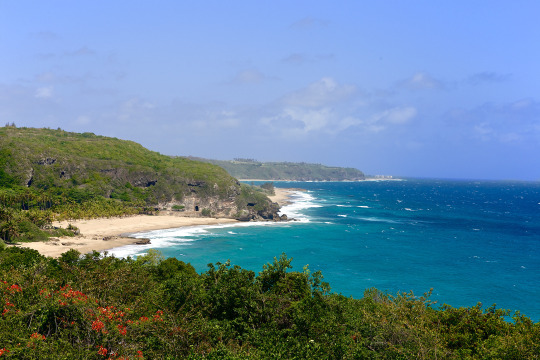
Merendero Guajataca and the Guajataca Tunnel in Puerto Rico
134 notes
·
View notes
Text
Get to know me:
Artist Name: VJ. Art
Real Name: Victor Jose
I am a Boricua Freelance Artist from Puerto Rico.
Zodiac sign: Sagittarius.
I like to take a road trip around the island to discover new places, take photos, and make lists to generate new ideas for my art.
I am very passionate about Extraterrestrial Fiction of UFOs, Cryptids, Fantasy Creatures, and Humanoid Monsters.
I really love taking my time drawing Female Characters.
My number one favorite band ever is Linkin Park.
Favorite colors: Red and Black.
Favorite food: Pizza/Sushi/Bacalaitos/Pinchos/Dark Chocolat.
My favorite games are Prototype, InFamous, Darksiders, and Skyrim.
Favored location: San Juan, Aguadilla, Cayey, Cabo Rojo and Ponce.
In this social space, you will see all of my OC's Artwork, and you may see some Illustrated Concepts of Sexual Adult Content and Non-Sexual Content, but I don't have many to show you. And just so you know, I am a very patient person with my art, and I take my time to try to finish the process of my work without rushing or being stressed, as my good Grandfather from Corozal told me.
"Too much in the Hurry & Stress, you won't go anywhere, and with too much Impatient you won't win Heaven."
Link: L1nkTr.33
I hope everyone enjoys my works as much as I enjoy creating them and I wish you all much success in your goals.
#new tumblr#artist on tumblr#istagram#new artist#get to know me#artistsoninstagram#artists on tumblr#hi tumblr#hi hello#hi guys#hello#hello tumblr#hello world
0 notes